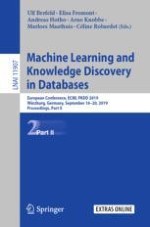1 Introduction
-
a new spectral mixture kernel that captures dependencies between components;
-
an extensive comparison between the proposed GCSM and other SM kernels in terms of spectral density, covariance, posterior predictive density and sampling, as well as in terms of performance gain.
2 Background
3 Related Work
4 Dependencies Between SM Components
5 Generalized Convolution SM Kernels
-
cross weight: \(w_{ij}=\sqrt{w_{i}w_{j}}\)
-
cross amplitude: \({a}_{ij}={\left| \frac{\sqrt{4\varSigma _{i}\varSigma _{j}}}{\varSigma _{i}+\varSigma _{j}}\right| }^{\frac{1}{2}}\exp \left( -\frac{{({\varvec{\mu }}_{i}-\varvec{\mu }_{j})^{\top }}({\varSigma _{i}+\varSigma _{j}})^{-1}({\varvec{\mu }}_{i}-\varvec{\mu }_{j})}{4}\right) \)
-
cross mean: \({\varvec{\mu }}_{ij}=\frac{\varSigma _{i}{\varvec{\mu }}_{j}+\varSigma _{j}{\varvec{\mu }}_{i}}{{\varSigma _{i}+\varSigma _{j}}}\);
-
cross covariance: \({\varSigma }_{ij}=\frac{{2{\varSigma _{i}\varSigma _{j}}}}{{\varSigma _{i}+\varSigma _{j}}}\)
6 Comparisons Between GCSM and SM
7 Scalable Inference
7.1 Hyper-parameter Initialization
8 Experiments
8.1 Compact Long Term Extrapolation
8.2 Modeling Irregular Long Term Decreasing Trends
8.3 Modeling Irregular Long Term Increasing Trends
8.4 Prediction with Large Scale Multidimensional Data
|
Kernel
|
CO\(_2\)
|
Ozon
|
Air
|
Abalone
|
Kernel
|
CO\(_2\)
|
Ozon
|
Air
|
Abalone
|
|---|---|---|---|---|---|---|---|---|---|
|
LIN
|
39.09
|
1.86
|
57.64
|
10.93
|
LIN
|
451.38
|
235.68
|
462.01
|
24261.35
|
|
SE
|
128502.50
|
10.40
|
4967.18
|
8.14
|
SE
|
399.90
|
208.53
|
456.68
|
21246.86
|
|
Poly
|
132369.70
|
11.36
|
5535.81
|
6.30
|
Poly
|
1444.80
|
375.86
|
735.39
|
17964.17
|
|
PER
|
53.37
|
3.87
|
276.07
|
7.98
|
PER
|
459.53
|
236.71
|
456.38
|
18775.23
|
|
RQ
|
985.39
|
1.86
|
168.33
|
5.38
|
RQ
|
222.17
|
196.96
|
430.86
|
15988.48
|
|
MA
|
110735.30
|
9.83
|
4711.33
|
7.52
|
MA
|
278.33
|
208.17
|
451.03
|
20288.56
|
|
Gabor
|
131931.30
|
2.09
|
5535.84
|
4.80
|
Gabor
|
1444.62
|
240.55
|
735.41
|
15400.84
|
|
FBM
|
193.18
|
2.56
|
172.01
|
–.–
|
FBM
|
910.61
|
202.42
|
457.792
|
–.–
|
|
ULL
|
117500.40
|
9.34
|
405.07
|
–.–
|
ULL
|
819.09
|
206.85
|
441.31
|
–.–
|
|
NN
|
326.81
|
1.69
|
116.66
|
5.60
|
NN
|
460.73
|
225.46
|
449.31
|
17695.80
|
|
SM
|
9.36
|
0.97
|
36.28
|
3.59
|
SM
|
62.09
|
160.75
|
328.56
|
8607.99
|
|
GCSM
|
1.19
|
0.59
|
10.02
|
3.29
|
GCSM
|
64.34
|
160.48
|
300.69
|
8566.35
|
